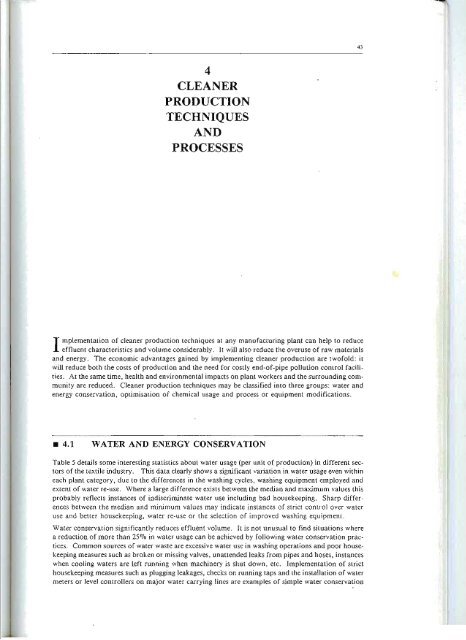Contributor, The Textile Industry and the Environment, UNEP
Contributor, The Textile Industry and the Environment, UNEP
Contributor, The Textile Industry and the Environment, UNEP
Create successful ePaper yourself
Turn your PDF publications into a flip-book with our unique Google optimized e-Paper software.
I<br />
4<br />
CLEANER<br />
PRODUCTION<br />
TECHNIQUES<br />
AND<br />
PROCESSES<br />
mplementation of cleaner production techniques at any manufacturing plant can help to reduce<br />
effluent characteristics <strong>and</strong> volume considerably. It will also reduce <strong>the</strong> overuse of raw materials<br />
<strong>and</strong> energy. <strong>The</strong> economic advantages gained by implementing cleaner production are twofold: it<br />
will reduce both <strong>the</strong> costs of production <strong>and</strong> <strong>the</strong> need for costly end-of-pipe pollution control facilities.<br />
At <strong>the</strong> same time, health <strong>and</strong> environmental impacts on plant workers <strong>and</strong> <strong>the</strong> surrounding community<br />
arc reduced. Cleaner production techniques may be classified into three groups: water <strong>and</strong><br />
energy conservation, optimisation of chemical usage <strong>and</strong> process or equipment modifications.<br />
• 4.1 WATER AND ENERGY CONSERVATION<br />
Table 5 details some interesting statistics about water usage (per unit of production) in different sectors<br />
of <strong>the</strong> textile industry. This data clearly shows a significant variation in water usage even within<br />
each plant category, due to <strong>the</strong> differences in <strong>the</strong> washing cycles, washing equipment employed <strong>and</strong><br />
extent of water re-use. Where a large difference exists between <strong>the</strong> median <strong>and</strong> maximum values this<br />
probably renects instances of indiscriminate water use including bad housekeeping. Sharp differences<br />
between <strong>the</strong> median <strong>and</strong> minimum values may indicate instances of strict control over water<br />
use <strong>and</strong> better housekeeping, water re-use or <strong>the</strong> selection of improved washing equipment.<br />
Water conservation significantly reduces effluent volume. It is not unusual to find situations where<br />
a reduction of more than 25010 in water usage can be achieved by following water conservation practices.<br />
Common sources of water waste are excessive water use in washing operations <strong>and</strong> poor housekeeping<br />
measures such as broken or missing valves, unattended leaks from pipes <strong>and</strong> hoses, instances<br />
when cooling waters are left funning when machinery is shut down, etc. Implementation of strict<br />
housekeeping measures such as plugging leakages, checks on running taps <strong>and</strong> <strong>the</strong> installation of water<br />
meters or level controllers on major water carrying lines are examples of simple water con.servation<br />
43

















